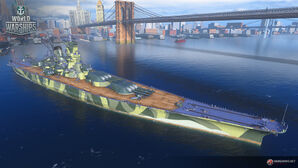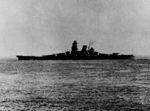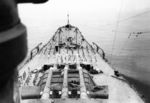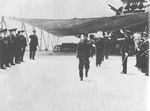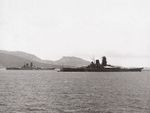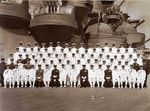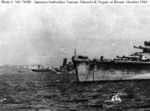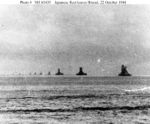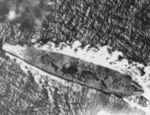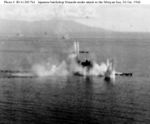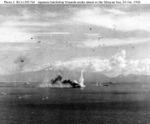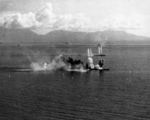Musashi
| Revision as of 02:42, 17 January 2018 signal flags | Revision as of 08:35, 17 January 2018 Added Service history. | |||
| Line 207: | Line 207: | |||
| Commissioned in mid-1942, ''Musashi'' was modified to serve as the flagship of the Combined Fleet, and spent the rest of the year working up. The ship was transferred to Truk in early 1943 and sortied several times that year with the fleet in unsuccessful searches for American forces. She was used to transfer forces and equipment between Japan and various occupied islands several times in 1944. Torpedoed in early 1944 by an American submarine, ''Musashi'' was forced to return to Japan for repairs, during which the navy greatly augmented her anti-aircraft armament. She was present during the Battle of the Philippine Sea in June, but did not come in contact with American surface forces. ''Musashi'' was sunk by an estimated 19 torpedo and 17 bomb hits from American carrier-based aircraft on 24 October 1944 during the Battle of Leyte Gulf. Over half of her crew was rescued. Her wreck was located in March 2015 by Microsoft co-founder Paul Allen and his team of researchers. | Commissioned in mid-1942, ''Musashi'' was modified to serve as the flagship of the Combined Fleet, and spent the rest of the year working up. The ship was transferred to Truk in early 1943 and sortied several times that year with the fleet in unsuccessful searches for American forces. She was used to transfer forces and equipment between Japan and various occupied islands several times in 1944. Torpedoed in early 1944 by an American submarine, ''Musashi'' was forced to return to Japan for repairs, during which the navy greatly augmented her anti-aircraft armament. She was present during the Battle of the Philippine Sea in June, but did not come in contact with American surface forces. ''Musashi'' was sunk by an estimated 19 torpedo and 17 bomb hits from American carrier-based aircraft on 24 October 1944 during the Battle of Leyte Gulf. Over half of her crew was rescued. Her wreck was located in March 2015 by Microsoft co-founder Paul Allen and his team of researchers. | |||
| ? | + | ===Design=== | ||
| + | ''Musashi's construction shipyard was surrounded by a ginormous curtain to make sure people couldn't spy on her by land. Instead, people spied on her by air. | |||
| + | ===Service=== | |||
| + | After 4 years of immensely secretive construction, super-battleship ''Musashi'' was commissioned into the Imperial Japanese navy on the 5th of August 1942, joining the 1st Battleship Division alongside ''[[Nagato]]'', ''[[Mutsu]]'', and her sister-ship ''[[Yamato]]''. Stationed at Nagasaki, she spent the rest of 1943 working up. She officially joined the Combined Fleet on the 15th of January 1943, under the command of Admiral Isoroku Yamamoto. She arrived at Truk one the 22nd of January, and replaced ''[[Yamato]]'' as the Combined Fleet’s flagship by the 11th of February. She remained at Truk until mid-May of 1943, where she sortied to the northern Pacific in response to American attacks on Attu island, but failed to make contact with American forces. She sortied a second time with an even stronger fleet shortly after, but was called back to Yokosuka after failing to reach Attu before the American forces captured it. On the 23rd of May, she embarked Yamamoto’s ashes and carried them to Tokyo for a formal state funeral. After returning to Yokosuka for thorough inspections, she was visited by Emperor Hirohito and his staff during late June. She returned to Truk by the 6th of August 1943, resuming her position as flagship of the Combined Fleet, now under the command of Admiral Mineichi Koga. | |||
| ? | + | Her next big sortie came on the 17th of October 1943. Having intercepted American radio traffic suggesting another raid on Wake Island, ''Musashi'' sortied from Truk at the head of a powerful fleet including five other battleships, three carriers, eleven cruisers and several dozen destroyers to intercept the American carrier force, but once again ''Musashi'' and her fleet fail to find the American forces. She spent the remainder of 1943 at Truk Lagoon where she functioned as the command ship for the region. She finally left Truk on the 10th of February 1944, when she returned to Yokosuka. After ''[[Yamato]]'' and ''Musashi'' were reassigned from the First Fleet to the Second Fleet, ''Musashi'' embarked several thousand men of the Imperial Japanese Army and the Special Naval Landing Forces and their equipment and set sail for Palau, arriving by the 29th of February where she remained until late March. On the 29th of March, ''Musashi'' departed Palau in the dead of night to avoid a potential air raid, but was discovered by submarine USS ''Tunny'', who fired off six torpedoes at ''Musashi'' and scored a hit on her port bow, tearing open a 5.6 meter diameter hole, flooding her with 2,630 tons of water. Before she departed Palau however, Admiral Koga departed ''Musashi'' via plane for the Philippines to set up a new headquarters at Davao. Admiral Koga’s plane was caught in a typhoon, and Koga perished. After momentary repairs, ''Musashi'' set sail for Kure, managing 24 knots under cover of darkness. Entering dry dock at Kure on the 10th of April 1944, the hole in her bow was properly repaired, while her anti-aircraft armament suite was substantially increased, with her wing 15.5cm turrets being removed to make more room for 25mm triple-mount AA guns, and her AA firepower was further improved by the addition of 4 more radars. | ||
| + | ||||
| + | In early May 1944, ''Musashi'' departed Kure bound for Okinawa, joined by six aircraft carriers and four destroyers. She then moved to Tawi-Tawi by the 12th of May, joining Vice Admiral Jisaburou Ozawa’s fleet alongside Yamato. She sortied towards Batjan on the 10th of June, preparing to launch a counterattack against the Allied invasion of Biak. Two days later, after receiving news of American attacks on Saipan, ''Musashi'' was diverted to the Mariana Islands, joining Vice Admiral Takeo Kurita’s 2nd fleet on arrival. She was present for the following Battle of the Philippine Sea, but was not attacked. Following the disastrous defeat at the hands of the numerically and technologically superior American Fast Attack Forces, ''Musashi'' and the survivors returned to Japan. On the 8th of July, ''Musashi'' and ''[[Yamato]]'' embarked 3,500 men and set sail for Lingga Island off Malaysia, arriving on the 17th of July. ''Musashi'' remained at Lingga performing training exercises until the 18th of October 1944, where she sailed for Brunei Bay in Borneo to join the main Japanese fleet building up for the planned counterattack against American landings at Leyte. ''Musashi'', at the head of Kurita’s “1st Diversion Force”, set sail for the Philippines on the 22nd of October. | |||
| + | ||||
| + | While transiting the Sibuyan Sea through the Philippines on the 24th of October, ''Musashi''’s fleet was spotted by American reconnaissance aircraft from American carrier USS ''Intrepid'' (CV-11). Two hours after being initially spotted, eight Helldiver dive bombers attacked ''Musashi'' with 1000-pound bombs; only one hit her No.1 Turret, and it failed to penetrate. Shortly after, a torpedo dropped by an Avenger (also from ''Intrepid'') struck her starboard amidships, tearing a hole and letting in 3,000 tons of water, as ''Musashi'' developed a 5.5-degree list. During this initial attack, two Avengers were shot down. An hour and a half later, another eight Helldivers from ''Intrepid'' fell upon ''Musashi'', this time with two bombs hitting; one failed to explode after striking the forecastle and penetrating two upper decks before passing through the bow flare above the waterline, while the second penetrated two decks and exploded in the middle deck, disabling several of her portside AA guns. Two minutes later, nine Avengers attack ''Musashi'', with three torpedoes striking her port side amidships. She pushed her engines up to her hampered top speed of 22 knots, while she opened fire with all her guns, including firing anti-aircraft Type 3 shells from her 18” guns – after the first salvo, her No. 1 turret is disabled and evacuated, and had its magazines flooded to prevent a possible explosion. An hour and a half later, 29 more aircraft attack ''Musashi''. Five Helldivers attacked her scoring two near misses, while six Avengers scored four more torpedo hits, one of which hitting forward of Turret No.1, causing a massive internal explosion and rendering most of the ship’s interior bow inaccessible. After the third attack, ''Musashi''’s speed had dropped to 20 knots, and she had sunk almost 13 feet into the water. Nevertheless, all her guns, including her two-remaining operation 18” triple turrets kept firing on the American aircraft. An hour after the third attack subsided, 69 US aircraft began the 5th attack on ''Musashi''’s fleet. At this point, ''Musashi'' was leaving a trail of oil in the water and appeared to be barely managing 8 knots. The first nine Helldivers from USS ''[[Enterprise]]'' (CV-6) scored four 1,000lb bomb hits, scoring three hits on the port bow and the fourth bomb destroying the chief steward’s office. Eight more Avengers attacked ''Musashi'' yet again, scoring three torpedo hits that appeared to leave her dead in the water, but ''Musashi'' was still pushing herself to 16 knots, but was steadily taking on more and more water. After further counterflooding to stabilise her, her speed falls to 13 knots. A mere ten minutes later, 75 aircraft attack ''Musashi''’s fleet, 37 of them directly targeting the mortally wounded ''Musashi''. Ten Helldivers attacked her, scoring three initial hits and further destroying ''Musashi''’s AA armaments. One of these bombs penetrated the bridge and detonated in the operations room, killing several of ''Musashi''’s high-ranking officers and totally annihilating the operations room. Three more bombs strike ''Musashi''’s superstructure, followed by another two. At this point, almost all ''Musashi''’s superstructure was either destroyed or in flames. Twelve more Avengers attacked her yet again, scoring eleven hits, with only two failing to explode, while one last bomb falls upon her decks. Her speed drops to six knots. | |||
| + | ||||
| + | By 16:21 on the 24th of October 1944, 259 aircraft had attacked ''Musashi''’s fleet, and ''Musashi'' herself took 19 torpedo hits, 17 bomb hits, and 20 near-misses from bombs. She hadn’t gone down yet though. Throughout this attack, ''Musashi''’s damage control parties had put in herculean effort to keeping her afloat, but by the late afternoon she was listing to port by 10 degrees and had sunk more than 26 feet into the water. In a desperate last-ditch effort to save her, all free hands and wounded men on board assembled topside starboard to counteract the list, and all consumables and timber on board are loaded onto the starboard side. Rear Admiral Toshihira Inoguchi personally went below decks to flood the crew’s spaces on the starboard side, several boiler rooms and the starboard outboard engine room. Inoguchi attempts to beach ''Musashi'', but by that point her engines had stopped entirely. By 19:15, ''Musashi'' was listing to port by 12 degrees, and Inoguchi gave the order to “standby to abandon ship”. The XO, Captain Kato Kenkichi assembled the crew on the aft starboard deck. The battle flag is lowered, and Rear Admiral Toshihira Inoguchi retires to his cabin, and is not seen again. By 19:30, ''Musashi'' was listing at 30 degrees and slowly began to turn over. Captain Kato gives the order to abandon ship, and to remove the Emperor’s portrait. Destroyers ''Kiyoshimo'' and ''Hamakaze'' move in to rescue 1,423 survivors, including Captain Kato, but 1,023 of her 2,399-man crew are lost, including Rear Admiral Toshihira Inoguchi, who was posthumously promoted to Vice Admiral. At 19:36 ''Musashi'' capsized to port completely, and sank by the bow. As the ship’s stern sank beneath the water, the aft turret fell off and two explosions were heard. The surviving sailors and officers are taken to Manila Bay, where they were designated the “Kato Regiment” after he name of their surviving second-in-command, Captain Kato, and joined in Japanese defensive operations both on land and at sea until the end of the war. On the 31st of August 1945, ''Musashi'' was removed from the Navy List. | |||
Revision as of 08:35, 17 January 2018
| 460 mm/45 Type 94 in a triple turret3 х 3 pcs. |
| Rate of Fire2 shots/min. |
| Reload Time30 sec. |
| Rotation Speed2.5 deg./sec. |
| 180 Degree Turn Time72 sec. |
| Firing Range26.5 km. |
| Maximum Dispersion274 m. |
| HE Shell460 mm HE Type0 |
| Maximum HE Shell Damage7,300 |
| Chance of Fire on Target Caused by HE Shell35 % |
| Initial HE Shell Velocity805 m./s. |
| HE Shell Weight1360 kg. |
| AP Shell460 mm AP/APC Type91 |
| Maximum AP Shell Damage14,800 |
| Initial AP Shell Velocity780 m./s. |
| AP Shell Weight1460 kg. |
| 127 mm/40 Type 89 on a Model A1 Mod.2 mount6 х 2 pcs. |
| Firing Range7 km. |
| Rate of Fire8 shots/min. |
| Reload Time7.5 sec. |
| HE Shell127 mm HE Type0 |
| Maximum HE Shell Damage2,100 |
| Initial HE Shell Velocity725 m./s. |
| Chance of Fire on Target Caused by HE Shell8 % |
| 155 mm/60 3rd Year Type in a triple turret4 х 3 pcs. |
| Firing Range7 km. |
| Rate of Fire5 shots/min. |
| Reload Time12 sec. |
| HE Shell155 mm HE Type0 |
| Maximum HE Shell Damage2,600 |
| Initial HE Shell Velocity925 m./s. |
| Chance of Fire on Target Caused by HE Shell10 % |
| 127 mm/40 Type 89 on a Model A1 Mod.2 mount6 х 2 pcs. |
| . . . Average Damage per Second60.6 |
| . . . Firing Range5.01 km. |
| IDS_PJGA004_25MM_TYPE96_TRIPLE_18 х 3 pcs. |
| . . . Average Damage per Second26.4 |
| . . . Firing Range2.49 km. |
| 13 mm/76 Type 93 on a twin mount2 х 2 pcs. |
| . . . Average Damage per Second4 |
| . . . Firing Range1.2 km. |
| 25 mm/60 Type 96 on a triple mount4 х 3 pcs. |
| . . . Average Damage per Second13.2 |
| . . . Firing Range2.49 km. |
| Maximum Speed27 knot |
| Turning Circle Radius900 m. |
| Rudder Shift Time18.7 sec. |
| Surface Detectability Range17.46 km. |
| Air Detectability Range12.79 km. |
Musashi — Japanese special premium Tier IX battleship.
A Yamato-class battleship, Yamato’s only sister ship to be commissioned. Just like Yamato, Musashi was the biggest warship of World War II. Upon completion, and in contrast to her subsequently modernized sister ship, she had more powerful secondary battery guns, but weaker AA defenses.
Modules
Compatible Upgrades
| Slot 1 |
||||
|---|---|---|---|---|
| Slot 2 |
||||
| Slot 3 |
||||
| Slot 4 |
||||
| Slot 5 |
||||
| Slot 6 |
Player Opinion
Performance
Musashi is the sister ship to Tier X Japanese battleship Yamato. As one might expect, the two share many commonalities; however, Musashi is a tier lower than her sister ship and somewhat weaker as a result. She retains the class's fearsome 18.1-inch guns, but sacrifices some general accuracy to do so. Her AA suite is also severely lacking compared to powerhouses like the Missouri, Iowa, or Friedrich der Große. Everything considered, captains that have played Yamato will know what to expect from Musashi. Both share key features such as their armor layout, health pool, stealth (or lack thereof), and speed. The two play very similarly, and overall feel quite comparable. That is not to say that they are entirely similar, however. As was mentioned, Musashi sacrifices two main things for her down-tiering.
First and foremost, she takes a massive reduction to her anti-aircraft suite. It would not be an exaggeration to say that the single largest threat to any Musashi captain will be an enemy aircraft carrier, as they can strike her with near impunity regardless of the tier of their planes; even an up-tiered carrier such as Hiryu or Ranger will have no trouble pushing home a bomber strike against Musashi. The severity of this weakness is somewhat mitigated by her astoundingly good torpedo belt — Musashi, like Yamato, has the best torpedo protection in the game. Captains should still keep this downfall in mind, however, as positioning themselves next to a ship with strong AA could mean the difference between sinking or staying afloat while a carrier is in play.
Yamato’s biggest strength is her guns; this holds true with Musashi, but with one major difference. While the Yamato has the best sigma value in the game at 2.1, Musashi has only has a 1.8 value. Sigma as a value only affects the shell groupings of a volley, causing them to trend towards being closer together as the value grows higher. Simply put, the higher the sigma, the tighter the shell groupings. There will always be outliers where shells go nowhere near a targeted ship, and even a ship with cataclysmically low sigma can have good accuracy as long as the dispersion value is similarly good. Put into context, all of that means that while Musashi is not inaccurate — she has the same dispersion value as Yamato — her shell groupings simply won't be as tight, on average.
Other than these two things, Musashi also has a very high and easy to hit citadel. Captains should actively avoid close passes against enemy battleships and heavy cruisers, and avail to angle towards enemy ships at all times. It's inadvisable to get caught up in the ship's expansive main battery range either, as her guns lose most of their effectiveness past the 15 km mark. Veterans of Yamato are likely already familiar with these two quirks of how the ship plays.
Musashi is essentially a weaker, downtiered Yamato. They play the same for the most part, sharing the same weaknesses and strengths. She is not a radical departure from general battleship play, and should be very comfortable to anyone who enjoys Yamato.Pros:
- 460 mm (18") guns are capable of penetrating the bow armor of every ship in the game at any range due to the overmatch rule.
- Very long range on the main battery guns.
- Long range secondaries; can reach up to 10.6 km with the proper build.
- Tight turning circle for a battleship.
- Tied with her Tier X sister, Yamato, for the best torpedo protection.
- Largest hit point pool at Tier IX, and second largest in the game, having 100 hp more than Yamato and beaten only by the Tier X Großer Kurfürst.
- Strong, reliable armor when angled properly against enemy ships; very strong horizontal armor offers protection against American AP Dive Bombers (still vulnerable to Graf Zeppelin AP bombs).
- Fairly good accuracy on her main battery.
Cons:
- Painfully slow turret traverse of 2.5 deg./sec.
- Very weak AA battery.
- She is slow, and cumbersome with a large turning circle, slow rudder shift, and low top speed.
- Majority of her secondary battery fires AP with struggles to do damage to angled targets.
- Tall flat sides make her vulnerable to citadels from broadside targets.
Research
Optimal Configuration
Upgrades
The recommended upgrades for Musashi are as follows:
- Slot 1: Main Armaments Modification 1
 *
*
- Slot 2: Damage Control System Modification 1

- Slot 3: Aiming Systems Modification 1
 *
*
- Slot 4: Damage Control System Modification 2

- Slot 5: Concealment System Modification 1

- Slot 6: Main Battery Modification 3
 *
*
Slot 1 provides players with the first option in choosing a desired role. Typically, Main Armaments Modification 1 is recommended to provide additional survivability to the main battery, but players who desire to specialize in the secondary or anti-aircraft armament should choose Auxiliary Armaments Modification 1 ![]() .
.
Slot 3 allows for further specialization. Generally, Aiming Systems Modification 1 is recommended because it reduces shell dispersion of the main and secondary armaments. To increase the effectiveness of the anti-aircraft armament, mount AA Guns Modification 2 (![]() ). Players wishing to specialize for secondaries should mount Secondary Battery Modification 1 (
). Players wishing to specialize for secondaries should mount Secondary Battery Modification 1 (![]() ).
).
Slot 6 gives players options to finalize their build. For gunnery, mount Main Battery Modification 3 to decrease the reload time of the main battery. Template:AA Guns Modification 3 should be mounted for AA duties to increase the DPS of AA guns. Players wishing to increase the effectiveness of the secondaries should mount Secondary Battery Modification 3 (![]() ).
).
Commander Skills
Key skills for all Musashi commanders include Priority Target, Expert Marksman, and Superintendent.
For commanders focusing on secondary armaments, key skills include Basic Firing Training, Advanced Firing Training, and Manual Fire Control for Secondary Armament.
For commanders focusing on anti-aircraft armaments, key skills include Basic Firing Training, Advanced Firing Training, and Manual Fire Control for AA Armament.
For commanders focusing on maximum survivability, key skills include Basics of Survivability, Fire Prevention, and Concealment Expert.
| Recommended Commander Skills | ||||||||
|---|---|---|---|---|---|---|---|---|
| Cost (points) |
Endurance | Attack | Support | Versatility | ||||
| 1 |
★★★ |
★★ |
|
|
|
|
★ |
|
| 2 |
★ |
★★ |
★★★ |
|
|
|
★★ |
|
| 3 |
★★ |
|
|
|
★★ |
★★★ |
|
★★ |
| 4 |
★★ |
★★★ |
|
|
★★★ |
|
|
★★ |
| Key: ★★★ - Extremely Useful ★★ - Frequently Useful ★ - Occasionally Useful No stars - Meh Χ - Not recommended | ||||||||
Consumables
Musashi can equip the following consumables:
- Slot 1: Damage Control Party

- Slot 2: Repair Party

- Slot 3: Spotting Aircraft
 or Catapult Fighter
or Catapult Fighter 
Premium versions of Damage Control Party ![]() and Repair Party
and Repair Party ![]() are recommended, as Musashi will often be detected and drawing fire. Captains can choose between the Spotting Aircraft
are recommended, as Musashi will often be detected and drawing fire. Captains can choose between the Spotting Aircraft ![]() or Catapult Fighter
or Catapult Fighter ![]() depending on personal preferences.
depending on personal preferences.
Camouflage
As a premium ship, comes included with Type 10 camouflage that lowers her detection radius, reduces the accuracy of incoming shells, reduces her repair costs, and increases the amount of experience she earns.
Signals
As a battleship, the Musashi has 8 slots for signal flags. Standard flags to take as a battleship are India Delta (![]() ), November Foxtrot (
), November Foxtrot (![]() ), and India Yankee (
), and India Yankee (![]() ). These flags help increase the survivability of the Musashi. In addition, Sierra Mike (
). These flags help increase the survivability of the Musashi. In addition, Sierra Mike (![]() ) will help the Musashi go slightly faster and Mike Yankee Soxisix (
) will help the Musashi go slightly faster and Mike Yankee Soxisix (![]() ) will boost the power of the already strong secondaries.
) will boost the power of the already strong secondaries.
Recommended Signal Flags 
| |||||
|---|---|---|---|---|---|
| Combat | |||||

|
 ★ |
 ★★★ |
 ★ |

|

|

|
 ★★ |
 ★ |
 ★★ |
 ★★★ |
 ★★★ |

|

| ||||
Gallery
Historical Info
Historical Gallery
Video
| Destroyers | II Tachibana |
| Cruisers | I Hashidate • II Chikuma • III Tenryū • III Katori |
| Battleships | II Mikasa |
| Aircraft Carriers | IV [[Ship:Hōshō (< 23.01.2019)|Hōshō (< 23.01.2019)]] • IV Hōshō • V [[Ship:Zuihō (< 23.01.2019)|Zuihō (< 23.01.2019)]] • VI [[Ship:Ryūjō (< 23.01.2019)|Ryūjō (< 23.01.2019)]] • VI Ryūjō • VII [[Ship:Hiryū (< 23.01.2019)|Hiryū (< 23.01.2019)]] • VII [[Ship:Kaga (< 23.01.2019)|Kaga (< 23.01.2019)]] • VIII [[Ship:Shōkaku (< 23.01.2019)|Shōkaku (< 23.01.2019)]] • VIII Shōkaku • VIII Kaga |
